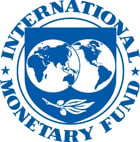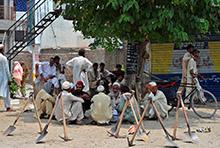
Typical street scene in Santa Ana, El Salvador. (Photo: iStock)
IMF Survey : Pakistan Gets $6.6 Billion Loan from IMF
September 4, 2013
- Pakistan faces slow growth, declining reserves, increasing fiscal deficit
- IMF loan aims at preserving economic stability, boosting growth
- Program includes measures to protect the most vulnerable and create jobs
The IMF's Executive Board has approved today a $6.6 billion loan for Pakistan to support its program to stabilize the economy and boost growth while expanding its social safety net to protect the poor.

Pakistani laborers sit underneath the shade as they await work. The IMF-supported program includes reforms that will help boost growth and create jobs (photo: Farooq Naeem/AFP/Newscom)
Pakistan’s Program
The 36-month program under the IMF’s Extended Fund Facility aims at bringing down inflation and reducing the fiscal deficit to more sustainable levels. The program also includes measures to help achieve higher and more inclusive growth, in particular through addressing bottlenecks in the energy sector.
Speaking to the IMF Survey, Jeffrey Franks, the IMF’s mission chief for Pakistan, explains the underlying reasons for the loan and the main ingredients and goals of the IMF-supported program.
IMF Survey: Why does Pakistan need financial assistance from the IMF?
Franks: Pakistan is in a difficult economic situation right now. Central Bank foreign exchange reserves have been falling and the chronic fiscal deficit has been widening. In addition, relatively high inflation and major structural impediments have stalled economic growth. On the top of all these issues, Pakistan does not have good sources of financial support from the international markets at this time and that’s why the government approached the IMF for financial assistance.
Countries normally borrow from the IMF when they have serious balance of payments difficulties. Pakistan is not yet in an economic crisis. The current account deficit of the balance of payments is actually relatively small by international standards—only around 1 percent of GDP. But, even that low deficit has not been adequately financed by capital inflows from abroad. Foreign direct and portfolio investment has been very low. As a result, Pakistan has been losing reserves over time, now reaching a critical low level of less than 1½ months of imports.
To avoid a full-blown crisis and a collapse of the currency, the government decided to seek financial assistance from the IMF. In addition, the World Bank, the Asian Development Bank and other partners have offered significant financial support for the adjustment and reform policies.
IMF Survey: Can you explain what an Extended Fund Facility means and why it’s right for Pakistan?
Franks: The Extended Fund Facility was established by the IMF in 1974 specifically for the countries with the types of problems that Pakistan has. These include inherently weak balance of payments position and chronic structural impediments. The Extended Fund Facility allows for longer programs and offers a longer maturity than Stand-By Arrangements—between 4½–10 years, which allows time for the structural reforms to be implemented and to bear fruit.
The duration of Pakistan’s program is three years, which gives the country enough time to implement the needed reforms. The extended repayment period will also make it easier for Pakistan when the repayment time comes.
IMF Survey: What are the main policy components of Pakistan's economic program and how would it help the country?
Franks: The program aims, first and foremost, at macroeconomic stabilization—that is, bringing the budget deficit down and reversing the balance of payments problems. This will require some tightening on both the fiscal and monetary sides in order to put the fiscal position on a sustainable path and reduce inflation. The program envisages a substantial decline in the budget deficit of the government from nearly 8.5 percent of GDP last year to 5.8 percent of GDP in 2013/2014 and to 3.5 percent of GDP by the end of the program. To achieve this, the authorities will substantially reduce tax loopholes and exemptions, broaden the tax base, and reduce tax evasion.
The financial support from the IMF and other international partners will help Pakistan overcome the balance of payments difficulties by stabilizing foreign exchange reserves and relieving pressure on the currency.
Beyond macroeconomic stabilization, the program includes substantial structural reforms that will help boost the long-term growth potential of the economy.
The most important of these is tackling the current energy crisis, which is a substantial drag on economic growth. The government has already launched a comprehensive energy policy, which will address energy supply, distribution, regulation, and pricing. The idea is to encourage more efficient consumption and better use of energy resources by reducing energy subsidies that currently go mainly to the rich. It is true that most people will pay more for energy, but, on the other hand, they will get energy more reliably and more consistently than they do now. And there will still be a subsidy for the poorest consumers. All of these measures—while they might not completely eliminate the massive blackouts that Pakistan is currently experiencing—will substantially reduce them over the duration of the program.
The program will also address reforms in trade policy, the financial sector, as well as those to improve the business climate. The government has also announced the privatization of some state-owned enterprises, with the aim of increasing economic efficiency and, hence, boosting growth.
All these reforms are going to take time. Growth may actually slip a little bit in the first year of the program because of the necessary fiscal adjustment and the time lag before the structural reforms yield fruit. However, we anticipate that growth should accelerate eventually from an average of 3 percent over the last several years to the vicinity of 5 percent by the end of the program.
IMF Survey: How will the program help protect the poor?
Franks: We have agreed with the government on a significant boost of targeted income support programs which would help the vulnerable groups, even with the reduction of untargeted subsidies. The number of families covered by this program will increase and the amount those families receive will grow. There will also be a new component of income support for poor families conditional on school attendance.
IMF Survey: Do you think the program can help create more jobs over time?
Franks: Creating more jobs will require achieving higher rates of economic growth. We think that restoring macroeconomic stabilization and alleviating some of the bottlenecks and inefficiencies in the economy—as outlined above—will help boost growth and job creation.
On the macroeconomic side, we should not forget that high budget deficits have been absorbing a disproportionate amount of the credit in the economy. This means that private businesses have not been able to borrow money to grow. In fact, private sector credit has declined in real terms in the last two years in Pakistan. Thus, reducing the deficit will free up financial resources so the private sector can get the credit necessary to grow and create jobs.
We also think that—by enhancing the business environment and reforming the financial sector—there will be a recovery of foreign direct investment into Pakistan, which will be another source of job creation.


